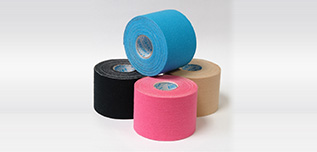
The tape you are referring to is known as Kinesiology Tape (or Kinesio Tape) and has become very popular amongst athletes and practitioners. It was developed by a chiropractor, Dr Kenso Kase, in the 1970s but became an overnight sensation in 2008 during the Beijing Olympics when the tape was donated to 58 countries for use during the games. Since then it has been used widely to prevent and relieve sporting injuries and a variety of other conditions.
The theory behind kinesiotape is that it:
- stimulates sensory pathways in the nervous system, increasing feedback to the brain
- lifts the skin and reduces pressure on pain receptors
- increases blood circulation to the taped area which may increase range of motion
- reduces fear of movement, which is associated with increased pain levels, thus increasing range of motion
- facilitates small immediate increases in muscle strength by pulling on the tissue of the muscle which may increase muscle contraction
- gives proprioceptive information to the brain if a joint is being stretched beyond normal limits
- may increase muscle activity
As Kinesio tape has only become popular in the last 5 years the research on its use and effectiveness is limited, mainly due to poor study designs. There has been some research (meta anaylsis by Williams et al. 2012) on the benefits of using kinesiotape in the following conditions:
- decreased pain in acute whiplash disorders (Gonzalez-Iglesias et al. 2009)
- improved range of motion in patients with a rotator cuff impingement (Thelen et al. 2008)
- improved biomechanics in baseball players with rotator cuff impingement (Hsu et al. 2009)
- in healthy individuals (with no injuries!) it has been shown to increase trunk flexion, extension and side flexion (Yoshida et al. 2007)
- increase in strength of lower trapezius muscle (an important shoulder stabilizer) and decreased activation of upper trapezius muscle (a muscle overactive in shoulder conditions) (Hsu et al. 2009)
- increased hand grip strength when tape is applied to wrist flexors (Lee et al. 2010)
- increased quadriceps peak torque (strength) (Vithoulka et al. 2010)
- increased VMO activation in patients with patellofemoral pain (Slupik et al. 2007)
Use of Kinesio Tape at Take Control
At Take Control Active Rehab we use kinesiotape for many conditions and particularly like using it around the neck, shoulder, lower back and hips. In saying that, we use it as an adjunct to our treatment to try and maintain the benefits gained from manual therapy. It is never used purely by itself to treat a condition.
We find that the tape is a lot more hypoallergenic compared to other types of tape that we have in the practice. Ask your physio if you would like more information on Kinesio Tape.


